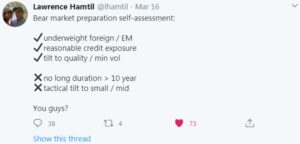
Lawrence Hamtil runs a wealth management firm in Overland, KS. He posted the above self-assessment on Twitter on his portfolio positioning prior to the COVID-19 market sell-off. I’ve never met or spoken with Lawrence, but kudos for his transparency and honesty.
Here’s an outline of what we got right & wrong in our portfolio positioning heading into the bear market of 2020.
What did we get right?
1. Our positioning was conservative entering 2020. A note from our year-end market commentary (published 1/16/2020):

2. We didn’t own any speculative fixed income i.e. high yield, preferred stocks, bank loans, emerging market debt, etc. Lower quality fixed income didn’t provide much of a safe-haven for investors:
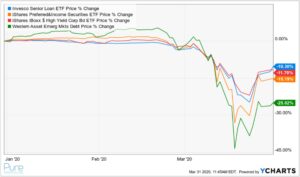
Source: Ycharts
The above graph shows year-to-date (as of 3/31) ETF returns for senior loans (blue), preferred stocks (orange), high yield bonds (red), and emerging debt (green). Many speculative bonds behave like equities during times of market stress.
3. We were focused on what we could control. Another note from our 2019 year-end market commentary…
4. We relied on empirical evidence when hedging client portfolios, not a narrative or opinion. For example, despite historically low-yields, U.S. Treasuries are still undefeated in hedging total portfolio risk. You can make a similar argument for gold…
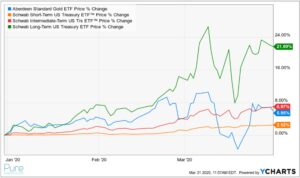
Source: Ycharts
The above graph shows several U.S. Treasury ETFs that have held up well in 2020. Investors that get hung up on yield will shun U.S. Treasury bonds to their detriment. You’re not buying a low-yielding Treasury to generate outsized return or yield, rather as a hedge against equities or other risky assets.
Having a rigorous, evidence-based filter helps us avoid asset classes that make for a great story, but are a disaster in practice. Look no further than the hedge fund proxies Wall Street crams into client portfolios. Per our blog, Hedge Fund Hold Up, the average Wall Street allocation has 17% in alternatives!
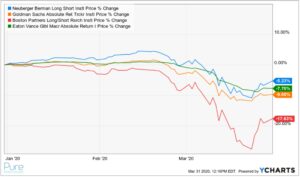
Source: Ycharts
The above chart shows a sampling of mutual funds that are supposed to mimic hedge fund strategies. You can see year to date (as of 3/31) returns leave much to be desired.
What did we get wrong?
1. Our allocation to global markets, international developed & emerging markets, continues to disappoint. Despite being much cheaper relative to U.S. equities, global markets haven’t provided much in the way of diversification (although they’ve been holding up a bit better lately).
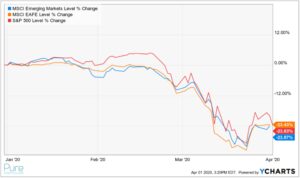
Souce: Ycharts
The above chart shows year to date price change (excluding dividends) for emerging markets (blue), international developed (orange), and the S&P 500 (red). Valuation is a decent tool for projecting longer-term returns (greater than 7 years), but is useless for predicting short-term returns. In this case, cheap international & EM stocks continue to get cheaper.
2. Pre-COVID, we felt comfortable getting our broad U.S. REIT exposure via index. The index owned every type of real estate from commercial offices to apartment complexes. Post-COVID, we believe commercial real estate will never be the same. We will still use low-cost ETFs to get our real estate exposure, but the allocation will be more intentional and specific.
3. We were disappointed with how certain high-quality bond ETFs held up during peak volatility. There were large deviations between the price of the ETF and the underlying net asset value (NAV) of the bonds. Under normal circumstances, bonds don’t trade like stocks. An individual municipal bond might not trade for weeks. Investors were panic-selling everything to get their hands on cash which created liquidity issues. The quirkiness of bonds created the perfect storm.
Therefore, our preference to buy individual bonds vs. bond ETFs is stronger than ever. We can target precisely what we want to own, i.e. credit quality, duration, maturity, and yield. We know exactly when coupon payments are made and when we get the principal investment back.
We empathize with investors that thought they were buying safe fixed income mutual funds & ETFs, only to discover the funds were loaded with garbage. We warned about this in a previous post, BBB Rated Movie.
4. We need a better way to identify the emotional & cognitive biases of clients before a market event happens. This leads to better-built portfolios and higher likelihood an investor sticks with the plan. In other words, how are they going to react during times of market stress? Low volatility and year after year of portfolio gains can lead to false confidence. You really get to know someone when stuff hits the fan.
Unfortunately, it’s impossible to simulate the emotions that market disruptions create. We can write about Planning for Ugly, Dump the Broken Risk Tolerance Questionnaire, Signs You’re Invested Incorrectly, Most Dangerous Thing, until we’re blue in the face. If the backdrop is a goldilocks economy and ascending markets, no one cares and we look like paranoid idiots.
We are not perfect. This is a great opportunity to question everything. How can we refine & improve our investment process? How can we better protect client capital from unforeseen events?
Hopefully this will inspire other financial advisors to self-assess. If you’re a client of another advisor, ask them what did right during the last 30 days. What would they change? How did your portfolio hold up?
This is the first time in 10+ years investors are taking a critical look at their portfolios.
Are you optimizing everything you can control?
